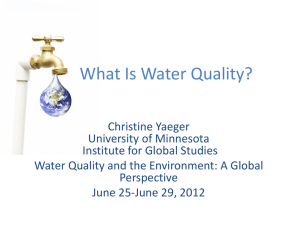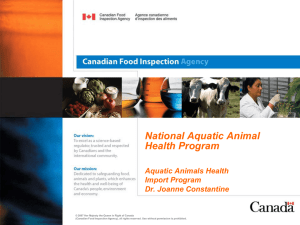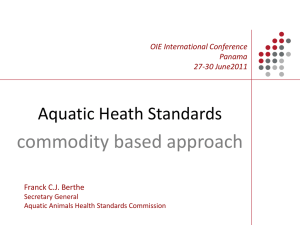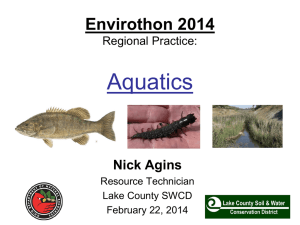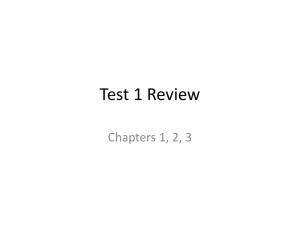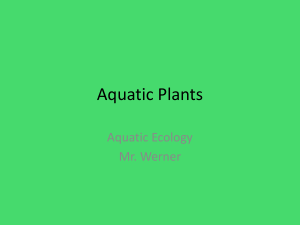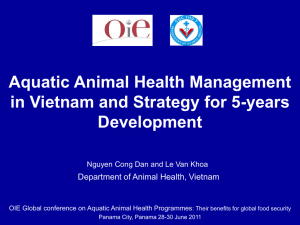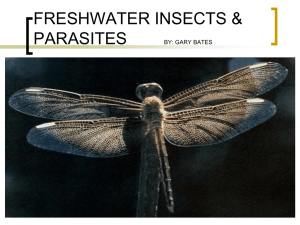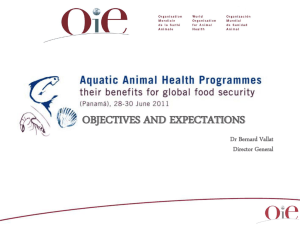What have we learnt when things go wrong?
advertisement
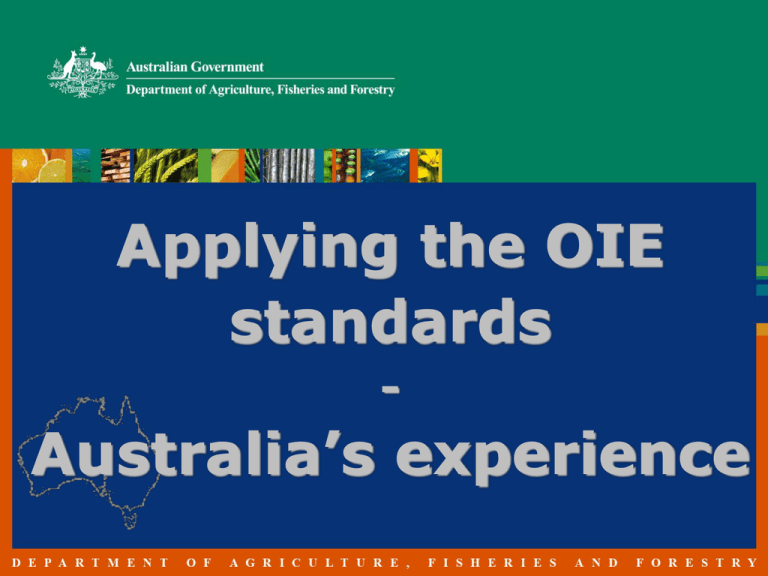
Applying the OIE standards - Australia’s experience Our Role & Responsibility Protect Australia’s favourable disease status Facilitate trade In healthy aquatic animals & their products Using OIE standards Types of Experience ASSESSMENT based on: DISEASE FREEDOM 1. Country 2. Zone The differences are never clearly defined 3. Zone / Compartment 4. Integrated Compartment 5. Partially Integrated/Single Compartment Assessment A 2-way process EXAMPLE: We assess Country X for ZONE freedom from shrimp disease. Country Y assesses us for supply of disease-free oyster spat. Assessment using the OIE standards Based on: PVS Tool - Aquatic Code - SPS Agreement & Australian Quarantine Legislation 1. Desk assessment 2. In-country visit About 9 months to get this far 3. An ongoing relationship, compliance, auditing, resourcing, management & sustainability PVS Tool CHAPTER I HUMAN, PHYSICAL AND FINANCIAL RESOURCES Section 1. Section I-1 Professional and technical staffing of the Veterinary Services Chapter 1.1. Section I-2 Competencies of veterinarians and veterinary para-professionals CAT FINDINGS Chapter 1.2. Section CRITERIA I-3 Continuing education Section I-4 Technical independence Chapter 1.3. Section I-5 Stability of structures and sustainability of policies LEGISLATION Chapter 1.4. Section I-6 Coordination capability of the Veterinary Services Section 2. S Import and export The Ministry of Agriculture, Department of Aquaculture (AD-MA) National Section I-7 Physical resources Chapter 2.1. legislation and/or Aquaculture Policies and Practices is the official regulation for all matters related to Chapter 2.2. Section I-8 Operational funding standards applicable aquaculture in Kingdom of Saudi Arabia (KSA). The AD-MA has approved the Section 3. Section I-9 Emergency funding to animal health contents of the AD-MA Manual of Procedures: Export of' Saudi Fishery Products to Section I-10 Capital investment Australia which contains the regulations related to theChapter export of3.1. fishery products to Section I-11 Management of resources and operations Australia. Section 4. CHAPTER II TECHNICAL AUTHORITY AND CAPABILITY Section II-1 Veterinary laboratory diagnosis Chapter 4.1. indicates that Article # 6-Policy on Introduction of Non-native Aquatic Organisms Section II-2 Laboratory quality assurance Chapter 4.2. into aquaculture there are restrictions on the importation of aquatic animals especially Section II-3 Risk analysis 4.3. units or projects. Criteria for the approval of import ofChapter aquatic animals were provided. Section II-4 Quarantine and border security Chapter 4.4. Additional policy documentation based on the systemChapter issued by4.5. Royal Decree No. Section II-5 Epidemiological surveillance M/9 dated 27/3/1408 (19/11/1987) was provided during the visit titled; Management Chapter 4.6. Section II-6 Early detection and emergency response of Fish Farms: A list of quality control of imported aquaculture in the Kingdom of Section II-7 Disease prevention, control and eradication Section 5. Saudi Arabia. Section II-8 Food safety Section II-9 Veterinary medicines and biologicals The following criteria were satisfied during the in-country visit. Section II-10 Residue testing Chapter 5.1. Section II-11 Emerging issues Chapter 5.2.of importing such advantages Section II-12 Technical innovation Adequate supporting evidence about the commercial species, when compared with the risk of introduction.Chapter 5.3. Section II-13 Identification and traceability Section II-14 Animal welfare Chapter 5.4. The Aquaculture Department (AD) is fully convinced of the need of introducing the CHAPTER III INTERACTION WITH STAKEHOLDERS Chapter 5.5. and confirmed new species. This has been demonstrated for fresh water aquaculture Section III-1 Communications during an on-site visit to a facility in Gassim, northern KSA. Section III-2 Consultation with stakeholders Chapter 5.6. Section III-3 Official representation Section III-4 Accreditation/authorisation/delegation Adequate facility and technical know-how are available in the research centres of Chapter 5.7. Section III-5 Veterinary Statutory Body the AD for quarantine/biosecurity procedures. Regional AD-MA centres throughout Chapter 5.8. Section III-6 Participation of producers other stakeholders in joint programmes KSA and are well resourced and provide support service to aquaculture Chapter 5.9. CHAPTER IV ACCESS TO MARKETS Section IV-1 Preparation of legislation and regulations Chapter 5.10. Section IV-2 Implementation of legislation and regulations and stakeholder compliance Section IV-3 International harmonisation Section 6. Section IV-4 International certification Chapter 6.1. Section IV-5 Equivalence and other types of sanitary agreements Chapter 6.2. Section IV-6 Transparency Section 7. Section IV-7 Zoning Chapter 7.1. Section IV-8 Compartmentalisation OIE code AQUATIC ANIMAL DISEASE DIAGNOSIS, SURVEILLANCE AND NOTIFICATION Notification of diseases and epidemiological information Criteria for listing aquatic animal diseases Diseases listed by the OIE Aquatic animal health surveillance CONCLUSIONS Y/N RISK ANALYSIS General considerations Import and export legislation under the mandate of Import analysisprovisions for animal health. the CA risk incorporates Y QUALITY OF AQUATIC ANIMAL HEALTH Import and export legislation incorporates SERVICES provisions for animal health; the CA actively and regularly participates at the international level in GENERAL RECOMMENDATIONS: the formulation and adoption of international DISEASE PREVENTION AND CONTROL standards, then harmonises the standards with their Zoning and compartmentalisation legislation. of compartmentalisation Application Quality of Aquatic Animal Health Services General recommendations on disinfection Contingency planning Fallowing in aquaculture Handling, disposal and treatment of aquatic animal waste The PAPERWORK TRADE MEASURES, IMPORTATION/EXPORTATION PROCEDURES AND HEALTH CERTIFICATION General obligations related to certification Certification procedures Criteria to assess the safety of aquatic animal commodities Control of aquatic animal health risks associated with transport of aquatic animals Aquatic animal health measures applicable before and at departure Aquatic animal health measures applicable during transit from the place of departure in the exporting country to the place of arrival in the importing country Frontier posts in the importing country Aquatic animal health measures applicable on arrival Measures concerning international transport of aquatic animal pathogens and pathological material Model health certificates for international trade in live aquatic animals and products of aquatic animal origin VETERINARY PUBLIC HEALTH Up to 500 pages of tables Control of hazards in aquatic animal feeds Introduction to the recommendations for controlling antimicrobial resistance WELFARE OF FARMED FISH Introduction to recommendations for the welfare of RESOURCES 5 staff – 4 with PhD’s in aquatic animal health Priority List Budget AUSTRALIA’S EXPERIENCE USING THE OIE STANDARDS POSITIVE FOCUS ON ISSUES & IMPROVEMENTS The first hurdle - contact WHY is the submission for trade access being made? QUALITY = COMMITMENT The RELATIONSHIP Principled negotiation in good faith First Contact: What have we learnt? Negotiations must be principled, transparent & held in good faith Clear channels of communication Roles & Responsibilities agreed Introduction to the system Expectations Priorities agreed First Contact: What have we learnt? The PVS Tool should recommend that countries develop a framework for the consistent & systematic evaluation of their trading partners’ animal health controls. This fosters confidence in the continuity & timeliness of the process. Legislation & Multiple Authorities Aquatic animals Fisheries Authorities Primary Industry Authorities Health Certification Authorities MOU’s EM-OH-YOUZ Memorandum of Understanding Legislation & Control: What have we learnt? Legislative arrangements for government control of aquatic animal industries & health are often complicated & may restrict market access until legal arrangements between the controlling authorities are secured. TIME is a major limiting factor 1 - 2 years: high quality – good health controls – good relations 5 years: No legislation – build controls from scratch – poor quality TIME is a major limiting factor What have we learnt? Negotiations - transparent & in good faith Good communications Consistent system Leadership QUALITY MANAGEMENT SYSTEMS No QMS is a major limiting factor Seamless systems integration Complete biosecurity management Traceability Reassurance for trading partners Basis for reporting Sustainability Continual feedback & improvement Connectors & QMS Animal Health Controls Internal Audit FUNCTION Manage DISEASE-FREE ZONE QUALITY MANAGER’S NETWORK R&D Training Surveillance Certification Laboratories Import Export Emergency OIE reporting Processor Connectors & QMS REPORTING Animal Health Controls Internal Audit R&D Import Export CONNECTOR OIE FOCAL POINT Certification Laboratories Training Surveillance Emergency Legal & Policy Processor QMS: What have we learnt? QMS is CRITICAL Function - Traceability - Improvement More consideration given to the importance of QMS in the PVS Tool critical competencies ‘One Health’ concept to integrate animal health controls – e.g. EQuIP When things go wrong Don’t panic… it’s not the end of the world, it’s a new beginning. Review your assessment. Review compliance. Observe emergency response & reporting. Review emergency preparedness. Review improvements. Does your system allow for continued trade? Start again using the Aquatic Code guidelines. What have we learnt when things go wrong? =Opportunity… …not Disaster Having systems in place provides a foundation to rebuild What have we learnt when things go wrong? Compartmentalise where possible COMPARTMENTS ZONE What have we learnt when things go wrong? The Aquatic Code Re-declaration of disease freedom e.g. WSSV = 2 years? Could be quicker for semi-closed closed systems - processing compartments CHAIN of CUSTODY: a CCP 3rd party & 3rd country processing Origin Approved Country A Origin Not Approved Country X Country B Processor Critical Control Point for substitution or contamination SAME Processor Country B Destination Approved fish Country C Chain of Custody: What have we learnt? Evaluation of the chain-of-custody (Product integrity) of aquatic animals & their products should be more thoroughly considered in the PVS Tool critical competencies BENEFITS of involvement Building stronger relationships Improve animal health controls Better ways to manage risk Consistent & successful way to facilitate trade without compromising biosecurity Special thanks to … OIE Aquatic Animal Health Standards Commission & member nations Dr Yuko Hood Dr Ramesh Perera Our aquatic team Dr Geoff Grossel Maps by Mark Kelly Dr Kally Gross

